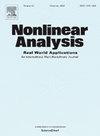Global stabilization and regulation of prey immigration for predator–prey models
IF 1.8
3区 数学
Q1 MATHEMATICS, APPLIED
引用次数: 0
Abstract
Observations of predator–prey dynamics in nature often reveal varying predation rates at different prey densities. However, the stabilizing or regulatory influence of constant prey immigration in predator–prey models incorporating a Holling type III functional response remains unclear. This study aims to address this issue by examining prey immigration as a stabilizing and regulating mechanism in ecosystems. This is achieved by employing a predator–prey model, with the predation process represented by a functional response involving Holling type III. The model admits at most one interior equilibrium point. A mathematical formulation is used to establish the interplay between the destabilization of the interior equilibrium point owing to increased carrying capacity and stabilization arising from constant prey immigration. Under certain conditions, an increase in carrying capacity disrupts the previously stable interior equilibrium point, resulting in the emergence of a stable limit cycle. The amplitude of this limit cycles grows as the carrying capacity increases, heightening the risk of ecosystem extinction. Conversely, constant prey immigration attenuates the destabilization of the interior equilibrium point and mitigates the amplification of the limit cycle. Necessary and sufficient conditions for global asymptotic stability of the interior equilibrium point and uniqueness of limit cycles are derived by transforming the model into a Liénard-type system with multiple parameters to validate these findings. The study findings enable the formulation of the effects of constant prey immigration on the stabilization and regulation in predator–prey models.
捕食-猎物模型猎物迁移的全局稳定与调控
自然界中对捕食者-猎物动态的观察常常揭示出不同猎物密度下不同的捕食率。然而,在包含Holling III型功能反应的捕食者-猎物模型中,恒定猎物迁移的稳定或调节影响尚不清楚。本研究旨在通过研究猎物迁移作为生态系统的稳定和调节机制来解决这一问题。这是通过采用捕食者-猎物模型实现的,捕食过程由Holling III型的功能反应表示。该模型最多允许一个内部平衡点。用数学公式建立了由于承载能力增加而引起的内部平衡点的不稳定与猎物不断迁移引起的稳定之间的相互作用。在一定条件下,承载能力的增加破坏了先前稳定的内部平衡点,导致稳定极限环的出现。随着承载能力的增加,这种极限环的幅度也在增加,从而加大了生态系统灭绝的风险。相反,恒定的猎物迁移减弱了内部平衡点的不稳定性,减轻了极限环的放大。通过将模型转化为具有多参数的lisamnard型系统,得到了内部平衡点全局渐近稳定和极限环唯一性的充分必要条件。研究结果为建立捕食者-猎物模型中恒定的猎物迁移对稳定和调节的影响提供了理论依据。
本文章由计算机程序翻译,如有差异,请以英文原文为准。
求助全文
约1分钟内获得全文
求助全文
来源期刊
CiteScore
3.80
自引率
5.00%
发文量
176
审稿时长
59 days
期刊介绍:
Nonlinear Analysis: Real World Applications welcomes all research articles of the highest quality with special emphasis on applying techniques of nonlinear analysis to model and to treat nonlinear phenomena with which nature confronts us. Coverage of applications includes any branch of science and technology such as solid and fluid mechanics, material science, mathematical biology and chemistry, control theory, and inverse problems.
The aim of Nonlinear Analysis: Real World Applications is to publish articles which are predominantly devoted to employing methods and techniques from analysis, including partial differential equations, functional analysis, dynamical systems and evolution equations, calculus of variations, and bifurcations theory.

 求助内容:
求助内容: 应助结果提醒方式:
应助结果提醒方式:


